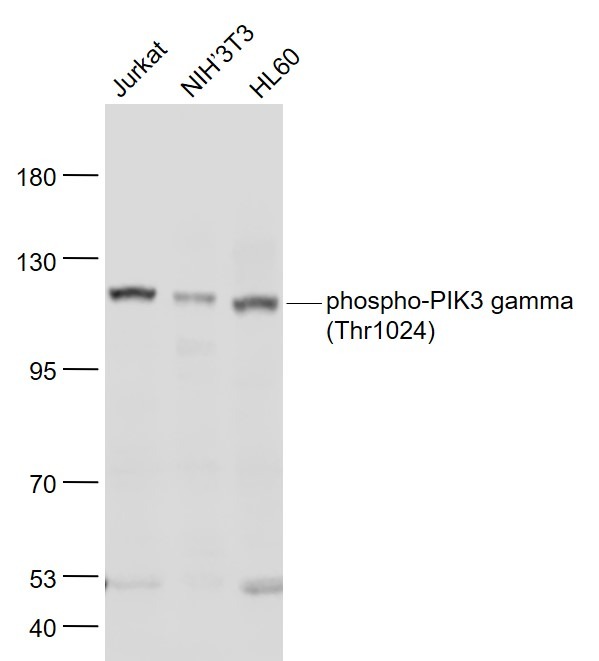Shopping Cart
Remove All Your shopping cart is currently empty
Your shopping cart is currently empty
Anti-Phospho-PIK3CG (Thr1024) Polyclonal Antibody is a Rabbit antibody targeting Phospho-PIK3CG (Thr1024). Anti-Phospho-PIK3CG (Thr1024) Polyclonal Antibody can be used in WB.
| Pack Size | Price | USA Warehouse | Global Warehouse | Quantity |
|---|---|---|---|---|
| 50 μL | $220 | 7-10 days | 7-10 days | |
| 100 μL | $373 | 7-10 days | 7-10 days | |
| 200 μL | $527 | 7-10 days | 7-10 days |
| Description | Anti-Phospho-PIK3CG (Thr1024) Polyclonal Antibody is a Rabbit antibody targeting Phospho-PIK3CG (Thr1024). Anti-Phospho-PIK3CG (Thr1024) Polyclonal Antibody can be used in WB. |
| Synonyms | Serine/threonine protein kinase PIK3CG, PtdIns-3-kinase subunit gamma, p-PIK3CG (Thr1024), p-PIK3CG (T1024), PIK3CG (p-Thr1024), PIK3CG (p-T1024), PIK3CG, PI3-kinase subunit gamma, PI3K-gamma, PI3Kgamma, Phosphoinositide-3-kinase catalytic gamma polypeptide, Phosphatidylinositol 4,5-bisphosphate 3-kinase catalytic subunit gamma isoform, Phosphatidylinositol 4,5-bisphosphate 3-kinase 110 kDa catalytic subunit gamma (PtdIns-3-kinase subunit p110-gamma;p110gamma), p120-PI3K, 5-bisphosphate 3-kinase catalytic subunit gamma isoform |
| Reactivity | Human,Mouse (predicted:Rat,Chicken,Dog,Pig,Cow,Horse,Rabbit,Sheep) |
| Verified Activity | Sample: Jurkat (Human) Cell Lysate at 30 μg NIH/3T3 (Mouse) Cell Lysate at 30 μg HL60 (Human) Cell Lysate at 30 μg Primary: Anti-phospho-PIK3 gamma (Thr1024) (TMAB-01481) at 1/1000 dilution Secondary: IRDye800CW Goat Anti-Rabbit IgG at 1/20000 dilution Predicted band size: 121 kDa Observed band size: 121 kDa  |
| Application | |
| Recommended Dose | WB: 1:500-2000 |
| Antibody Type | Polyclonal |
| Host Species | Rabbit |
| Subcellular Localization | Cytoplasm. Cell membrane. |
| Tissue Specificity | Pancreas, skeletal muscle, liver and heart. |
| Construction | Polyclonal Antibody |
| Purification | Protein A purified |
| Appearance | Liquid |
| Formulation | 0.01M TBS (pH7.4) with 1% BSA, 0.02% Proclin300 and 50% Glycerol. |
| Concentration | 1 mg/mL |
| Research Background | This gene encodes a protein that belongs to the pi3/pi4-kinase family of proteins. The gene product is an enzyme that phosphorylates phosphoinositides on the 3-hydroxyl group of the inositol ring. It is an important modulator of extracellular signals, including those elicited by E-cadherin-mediated cell-cell adhesion, which plays an important role in maintenance of the structural and functional integrity of epithelia. In addition to its role in promoting assembly of adherens junctions, the protein is thought to play a pivotal role in the regulation of cytotoxicity in NK cells. The gene is located in a commonly deleted segment of chromosome 7 previously identified in myeloid leukemias. [provided by RefSeq, Jul 2008]. |
| Immunogen | KLH conjugated synthesised phosphopeptide: human PIK3 gamma around the phosphorylation site of Thr1024 |
| Antigen Species | Human |
| Gene Name | PIK3CG |
| Gene ID | |
| Protein Name | Phosphatidylinositol 4, 5-bisphosphate 3-kinase catalytic subunit gamma isoform |
| Uniprot ID | |
| Function | Phosphoinositide-3-kinase (PI3K) that phosphorylates PtdIns(4,5)P2 (Phosphatidylinositol 4,5-bisphosphate) to generate phosphatidylinositol 3,4,5-trisphosphate (PIP3). PIP3 plays a key role by recruiting PH domain-containing proteins to the membrane, including AKT1 and PDPK1, activating signaling cascades involved in cell growth, survival, proliferation, motility and morphology. Links G-protein coupled receptor activation to PIP3 production. Involved in immune, inflammatory and allergic responses. Modulates leukocyte chemotaxis to inflammatory sites and in response to chemoattractant agents. May control leukocyte polarization and migration by regulating the spatial accumulation of PIP3 and by regulating the organization of F-actin formation and integrin-based adhesion at the leading edge. Controls motility of dendritic cells. Together with PIK3CD is involved in natural killer (NK) cell development and migration towards the sites of inflammation. Participates in T-lymphocyte migration. Regulates T-lymphocyte proliferation and cytokine production. Together with PIK3CD participates in T-lymphocyte development. Required for B-lymphocyte development and signaling. Together with PIK3CD participates in neutrophil respiratory burst. Together with PIK3CD is involved in neutrophil chemotaxis and extravasation. Together with PIK3CB promotes platelet aggregation and thrombosis. Regulates alpha-IIb/beta-3 integrins (ITGA2B/ ITGB3) adhesive function in platelets downstream of P2Y12 through a lipid kinase activity-independent mechanism. May have also a lipid kinase activity-dependent function in platelet aggregation. Involved in endothelial progenitor cell migration. Negative regulator of cardiac contractility. Modulates cardiac contractility by anchoring protein kinase A (PKA) and PDE3B activation, reducing cAMP levels. Regulates cardiac contractility also by promoting beta-adrenergic receptor internalization by binding to ADRBK1 and by non-muscle tropomyosin phosphorylation. Also has serine/threonine protein kinase activity: both lipid and protein kinase activities are required for beta-adrenergic receptor endocytosis. May also have a scaffolding role in modulating cardiac contractility. Contributes to cardiac hypertrophy under pathological stress. Through simultaneous binding of PDE3B to RAPGEF3 and PIK3R6 is assembled in a signaling complex in which the PI3K gamma complex is activated by RAPGEF3 and which is involved in angiogenesis. |
| Molecular Weight | Theoretical: 121 kDa. |
| Stability & Storage | Store at -20°C or -80°C for 12 months. Avoid repeated freeze-thaw cycles. |
| Transport | Shipping with blue ice. |
| Size | Quantity | Unit Price | Amount | Operation |
|---|

Copyright © 2015-2025 TargetMol Chemicals Inc. All Rights Reserved.